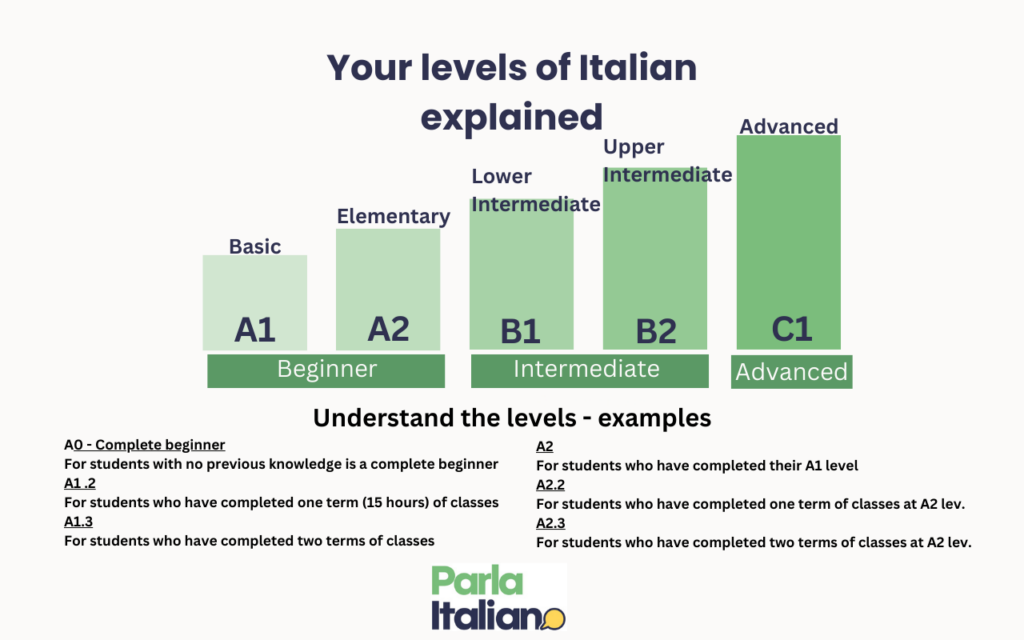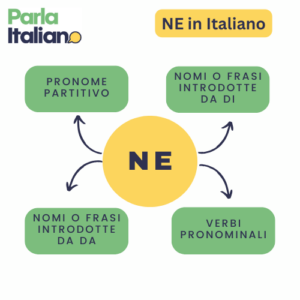Are you just starting to learn Italian, perhaps you are at the A1 level? If so this blog is for you. In this article, we explore how to learn Italian from scratch, how to make progress, study effectively, learn vocabulary, and more. This is what we cover:
- What is the A1 level?
- How quickly can I progress in Italian?
- How to study Italian
- Fun language games and activities
- 5 tips for developing Italian vocabulary
- Graded books (with a free e-book for A1)
- Build your confidence in Italian
- Success stories
.
What is the A1 level?
Understanding levels in language learning is beneficial as all schools in Europe use the European Framework for Languages to classify students across levels from A1 to C1.

The A1 level marks the beginning of your journey in learning Italian. If you have never studied before, you are a complete beginner, sometimes called A0. However, within the A1 level, various sub-levels are depending on the duration of your study. Working towards your A1 level means progressing from absolute novice to a basic understanding of the language. Typically, if you’re taking lessons once a week, you can expect to complete your A1 level after about 4 terms.
For instance, at our school, we offer specific courses tailored to your progress. If you’ve been studying for two terms, you’ll be placed in our A1.3 course. Similarly, if you’ve completed three terms, you’ll enrol in our A1.4 course. After completing the A1 level, you’ll then move on to working towards your A2 level.
.
How quickly can I progress?
Whether you’re just starting or have completed a couple of terms of Italian, the A1 level offers exciting benefits. Progress at this stage is easily and quickly noticeable. In as little as six months, significant improvements in your language skills can be achieved. Furthermore, if your class allows you to speak and to practise straight away what is taught, progress can be obtained even faster.
.
How to study Italian
To make the most of your A1 level studies and progress rapidly, it’s essential to establish a routine, find your motivation and most importantly have fun in the process. Here are our 3 tips in more detail:

1. Establish a routine
To learn quickly, students need to practise regularly. However, with all the demands of our modern life, this is easier said than done. The best thing is to establish a routine to ensure that studying becomes a habit. An effective way to establish it is to stack a new habit onto another that you already have.
Camilla’s story
One of my students, Camilla, found it difficult to find time for homework, so I suggested a stacking technique. She mentioned that she enjoyed doing some shopping on Mondays at around mid morning. So, I suggested that before going out shopping, she found 15-20 minutes to do the assigned homework and use the shopping as a reward. So, an established routine will allow us to remember to do another task, which over time will become a routine. Doing something as a routine means that it gets done without too much friction and can be maintained in the long run.
Set aside dedicated time each week to review vocabulary, practice listening and reading and a bit of writing. It might be difficult to organise and keep the work in balance, however, enrolling in a class helps as all the planning is done by the teacher.
2. Find your motivation
Motivation is key when learning a language. Language skills take quite a bit of time to develop so to keep you going you need to identify your reasons and specify your goals. This will fortify your determination. For instance, if you aim to speak a language while on holiday, focus on that objective and define what you want to achieve, the situations you want to navigate comfortably, and your desired proficiency level.
Emma’s story
My student Emma told me that her motivation for learning Italian was to travel to Italy with confidence. So, I suggested that she make some travel plans, booking well ahead of time. Her booked trip worked as a constant reminder and motivation.
But let’s say that you cannot travel at the moment, then another way could be to identify a short YouTube video that is most interesting to you but you cannot yet understand. I would suggest you attempt to watch it anyway once. Keep a note of how you feel about the video and how much you understand. After you have taken classes and studied for a few months, go back to the clip, attempt it again and write down your impressions., Has something changed? For example, can you understand a few more words than before?
Having something practical to look forward to and to measure progress is a great way to motivate language students.
Another way of measuring your progress is to take a test, we have one on our website here is the link. Make a note of the results and then come back after 6 months to see progress.
Additional benefits
Motivations for learning vary, ranging from travelling and cultural understanding to socializing or communicating with family and friends. Regardless of your goal, recent scientific research reveals an additional benefit: learning a language is a genuine brain workout, altering brain networks both structurally and functionally. Similar to physical exercise, the more you engage specific areas of your brain, the more they develop and strengthen. Hence, it’s never too late to learn, benefiting both young and older learners.
3. Make it fun!
To learn any complex skill requires time and the determination to keep going. So, having fun can make a huge difference. At Parla Italiano we understand this and use games and fun activities in our classroom.
I’d like to encourage you to play and use games at home as well.

Fun games and activities
I have selected some games specifically for learning vocabulary at the A1 level.
Here is a list with their link, so that you can start having some fun:
- Food (at the restaurant)
- Objects in the house
- The weather
- Hobbies
- Family vocabulary
- Colours
- Present tense of regular verbs
- Animals

5 tips for developing Italian vocabulary
1. Keep a Vocabulary Journal
Writing down new words is a highly effective strategy for memory retention. The physical act of writing helps reinforce the learning process, and many individuals find it easier to recall information when it’s written down.
You can enhance this technique by including its article, for example instead of writing pane, write il pane. So that the article will remind you that the word is masculine. Furthermore, you can include the translation in English, definitions, pronunciation guides, or even illustrations. The more connections you create between the word and its meaning, the stronger your memory retention will be.
2. Regularly Review New Vocabulary
Merely studying new vocabulary once isn’t enough for effective learning. Research indicates that without regular review, individuals typically retain only 20–25% of the studied material. To ensure that what you learn sticks in your long-term memory, schedule regular review sessions.
A fun way of reviewing vocabulary is to make cheat sheets. They can include groups of words classified in different way.
I have prepared one for you which includes your first 50 words in Italian. Download it here.
Consistently reviewing your vocabulary for just five minutes a day can significantly improve retention rates.
3. Learn from Context
Understanding the context in which a word is used is essential for effective vocabulary acquisition. Context helps you infer the meaning of unfamiliar words, demonstrates their usage in sentences, and aids in long-term retention. Learning new words from texts and listening activities is the most effective option.
For instance, instead of simply memorizing “fare” = to make/to do grasp its usage in a sentence like “Oggi, Fiorella fa la torta” This approach provides valuable information about meaning, usage, and word order.
4. Practice Makes Perfect
The principle of “use it or lose it” underscores the importance of actively using new vocabulary to reinforce learning. Incorporate newly acquired words into your speaking and writing as soon as possible. By practising frequently used words and phrases, you enhance your language proficiency and retention. Research suggests that actively engaging with a word—such as asking someone how to say it—accelerates the learning process.
This is why our classes are focused on speaking, to give our students the maximum time to practise and to use what is learned.
5. Engage in Reading
Reading is a powerful tool for language acquisition, akin to immersing yourself in the language through your imagination. Beyond its overall benefits for language proficiency, reading is particularly effective for learning new vocabulary. Contextualizing words within a story makes them more memorable compared to memorizing isolated word lists.
Did you know that you can enjoy reading even at the A1 level? The key is to start with graded books.

Graded books
Graded books are specifically designed for language learners and are tailored to suit various proficiency levels. Typically, books at the A1 level contain no more than 500 words, making them accessible for beginners. These books introduce vocabulary in context, aiding in easier memorization.
Here’s a fantastic resource I found online: “Italian Easy Readers, Il ristorante, Level A1”. It’s a free book designed specifically for beginners, allowing you to practice your Italian without any cost:
Italian Easy Readers, Il ristorante, Level A1
Additionally, here’s an example of a book published by Alma Edizioni, the page comes with some exercises to help develop your vocabulary. You can download free the first chapter and exercises: click here.
.
Building confidence
I have already written about building confidence in language learning and my idea is a very simple one. It comes down to 3 principles:
- Stop comparing yourself to others.
- Remember where you started from and how far you have come.
- Relax… follow the process, trust your teacher, take your time.
Here is my full answer if you wish to read further.

Success stories
Cathy Matthews
‘I really enjoy my Italian lessons at Parla Italiano, my teacher makes classes fun. I also like having fellow students, rather than just studying solo. I have been using Duolingo, which is great for practice, but you can’t ask ‘it’ any questions and it doesn’t explain grammar! My teacher explains topics well and is available to answer questions (and she’s very smiley).’
Themoulla Nicola
‘I have just completed my second course with Parla Italiano, having started as a complete beginner. I have really enjoyed both courses and feel like I have learnt so much already. I have a great teacher, who is always so positive and supportive. She makes learning fun! I also really like the fact that the classes are held by Zoom so slot into my day really easily – I love that I can learn Italian in my lunch break.’
Patrick Wiltshire
‘I’ve completed two courses and I can’t wait to start the next one. The Zoom classes work well and our teacher ensures all the elements are there for effective learning in each lesson. Our teacher keeps the lessons fun and engaging and the lessons always feel focused and well-planned. Grazie Parla Italiano!’
Jackie Bishop
‘The course and teaching methods are excellent. Each session is well structured with elements of both revision and new material. Teaching methods vary widely and generally incorporate fun exercises, listening and language practice. The atmosphere is encouraging and light with plenty of practical examples in both grammar and conversation. My teacher is patient and positive. I can’t think of anything negative about the whole experience.’
Jason Maratos
I have been studying Italian with Parla Italiano for about a year. My teacher is extremely effective. Her approach was consistent from the beginning and prompted me to speak Italian as much as I could. Over time with her support I found that my vocabulary has expanded and I am more comfortable speaking the language. She is enthusiastic, well prepared and makes sure the lessons are fun.
Now it’s your turn
What strategies are you most excited to try from this guide to accelerate your Italian language journey? Let me know in the comments and happy learning!







